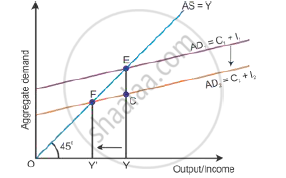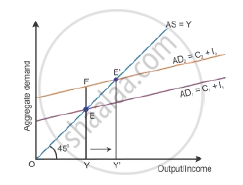Advertisements
Advertisements
Question
Explain national income equilibrium through aggregate demand and aggregate supply. Use diagram. Also explain the changes that take place in an economy when the economy is not in equilibrium
Solution
Aggregate demand and aggregate supply approach (AD and AS approach) Equilibrium level of income are attained only when aggregate demand is equal to aggregate supply. It is the level of output where producers plan to produce the amount of good is equal to consumers plan to purchase the amount of good. Thus, equilibrium is struck where planned output (AS) is equal to planned expenditure (AD) during a period of time.

Deficient demand occurs in a situation when the aggregate demand is short of the aggregate supply corresponding to full employment in the economy. It leads to a fall in the general price level and results in deflation, i.e. AD < AS. Aggregate demand is shown by the AD curve and aggregate supply is shown by the AS curve (as shown in the diagram below). While the aggregate demand curve and the aggregate supply curve intersect each other, the full employment equilibrium is attained at Point E. OY is the full employment level of output, and EY is the aggregate demand at full employment level of output. If the aggregate demand decreases below the full employment level of output from EY to CY, then the economy will have deficient demand, (EY − CY = EC).

Excess demand occurs in a situation when aggregate demand is more than aggregate supply corresponding to full employment. It leads to the reduction in inventories and inflation in the economy. This situation is considered an inflationary gap—the difference between aggregate demand beyond full employment and aggregate demand at full employment. Aggregate demand is the AD curve and aggregate supply is the AS curve (as shown in the diagram below). While the aggregate demand curve and the aggregate supply curve intersect each other, the full employment equilibrium is attained at Point E. OY is the full employment level of output, and EY is the aggregate demand at full employment level of output. If the aggregate demand increases beyond the full employment level of output from EY to FY, then the economy will have excess demand (FY − EY = FE).

APPEARS IN
RELATED QUESTIONS
Given consumption curve, derive saving curve and state the steps taken in the process of derivation. Use Diagram.
Define aggregate supply?
Explain the role of Repo Rate in reducing the Inflationary gap.
Explain the role of 'Open Market Operations' in reducing Deflationary Gap
What is 'consumption function'?
Write explanatory answer:
What is Aggregate demand ? Explain the determinants of Aggregate demand.
State with reason whether you agree or disagree with the following statements. (any Three)
Aggregate demand depand only on the consumption expenture.
State whether the following statements are True or False with reason:
Income earned from foreign investment is considered for aggregate demand.
Fill in the blank with appropriate alternatives given below
That part of income, which is not spent on consumption, is called __________.
Match the following Group:
| Group A | Group B | ||
| 1) | Aggregate Supply | a) | Expected receipts |
| 2) | Autonomous Investment | b) | Lord J. M. Keynes |
| 3) | Consumption | c) | Government Investment |
| 4) | A.P.C. | d) | ΔC/ΔY |
| 5) | Investment | e) | C/Y |
| f) | Addition to stock of capital | ||
| g) | Destruction of utility | ||
Give reason or explain.
Aggregate demand is a positive function of the level of employment and output.
Distinguish between:
Aggregate Demand and Aggregate Supply
Answer the following question:
What are the determinants of Aggregate Supply (AS)?
Keynes theory is associated with ______
Aggregate supply is equal to ______.
Identify the correctly matched pair from Column A to Column B:
| Column A | Column B |
| (1) Y = AD | (a) Level of output at full employment |
| (2) Forward Multiplier | (b) Withdrawal of investment decreases income |
| (3) Paradox of Thrift | (c) People save less or same as before |
| (4) Multiplier (k) < 1 | (d) 0 < MPC < 1 |
What is the circumstance when aggregate output is determined solely by the level of aggregate demand called?
If TR is 1,00,000₹ when ₹20,000 units are sold, then AR is equal to:
“In an economy Planned spending is more than Planned output”.
Explain its impact on the level of output, income and employment.
With reference to Simple Keynesian model, give the meaning of ex-ante demand.
